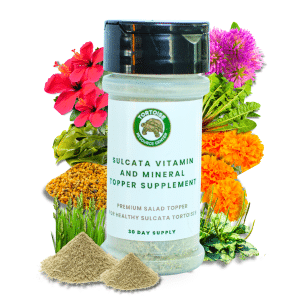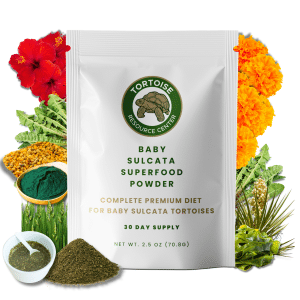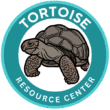The red-footed tortoise (Chelonoidis carbonarius), also referred to as the cherry head tortoise is a charming species and is commonly kept as a pet. It’s native to South America and is most easily identified by the red patches along its legs and the sides of its head.
In this article, I discuss everything you should know about a red-footed tortoise’s lifespan and what keepers can do to maximize the longevity of their pet. I also offer advice about expectations for growth, plus housing and feeding your tortoise throughout its different life stages.
Life Stages
Like all other species, the life cycle of red-footed tortoises involves several distinct stages from its tiny hatchling stage to becoming a fully-grown adult. Throughout their life, these tortoises experience distinct growth phases, with notable differences in size, behavior, and sexual maturity between males and females, here’s a look at each stage in more detail.
Hatchling Stage
When they first hatch, males and females are indistinguishable and they measure less than 2 inches long. They have a slightly domed, soft shell, which hardens as they grow, and the carapace is usually dark with yellow or red spots on each scute.
At this stage, whether in the wild or as captive creatures, survival is critical and they must rely heavily on environmental conditions and proper care for growth. Even at this early stage, they begin eating vegetation and require high humidity for proper shell development.
After a year, the typical red-footed tortoise measures between 3 and 3.5 inches.
Juvenile Stage
Beyond the first year, red-footed tortoises continue to grow rapidly for the next 5, meaning that by the end of the juvenile stage, they can reach 6-8 inches in length.
During this growth phase, juveniles require a calcium-rich diet for shell and bone development, and UV exposure is essential for healthy growth.
As juveniles, their shell becomes more defined, though it remains slightly domed. The distinct red or orange markings on the limbs and head become more prominent. It’s still not possible to determine their sex just by looking at them.
Sub-Adult Stage
Between the ages of 5-10 years, tortoises are classed as sub-adults, and typically, they grow to about 10-12 inches in length. The shell becomes more solid and robust, and the tortoise begins to resemble its adult form.
By this stage, sexual dimorphism becomes more apparent. Males tend to develop longer tails and a concave plastron (underside of the shell), while females have a flatter plastron and are often larger in size.
Around 5-7 years, red-footed tortoises may begin to show signs of sexual maturity, though full sexual maturity is often reached between 8-10 years. They may start exhibiting mating behaviors such as biting and nudging.
Adult Stage
Sexual maturity is fully achieved between 8-10 years, and this is classed as adulthood. The average adult red-footed tortoise measures 12 to 16 inches long and weighs 20 to 30 pounds. However, some individuals can grow up to 24 inches long!
However, they can vary in size depending on sex, genetics, and overall health. Female red-footed tortoises are considerably smaller (on average) than their male counterparts.
Females tend to exhibit a flat plastron to accommodate egg-laying. While males have a longer tail and a more pronounced concave plastron.
Their behavior changes as they mature, with males becoming more territorial and aggressive during mating seasons, while females become more focused on nesting.
Senior Stage
From 20 years and over, Red-footed tortoises are considered to be in their senior stage of life where growth slows, and they typically maintain a stable size.
Red-footed tortoises can remain fertile and active well into their senior years. However, activity levels tend to decrease with age. For keepers, it is important to maintain proper care during this time, including diet and environmental control. It also becomes increasingly important to maintain health and prevent age-related issues such as shell degradation or bone problems.
A healthy red-footed tortoise can live 50 to 70 years in captivity.
Are You Starving Your Tortoise?
Save 10% on premium tortoise food and supplements from Tortoise Resource Center on Amazon now using code BUYNOWGET10

Sulcata Vitamin & Mineral Topper Supplement
30-Day Supply | 2 oz (56 g)
$24.99

Baby Sulcata Tortoise Superfood Powder
30-Day Supply | 2.5 oz (70.8 g) Bag
$24.99
Housing Requirements Based on Age and Size
For red-footed tortoises, you want to provide an enclosure that is at minimum 10 times larger than the tortoise itself. The minimum recommended enclosure for an adult red-footed tortoise is about 6 by 8 feet.
This is a solitary species, so each tortoise should have its own enclosure. An exception can be made for very young tortoises, but you’ll need to provide extra space for each additional animal.
Indoor Housing Solutions
First things first, red-footed tortoises rarely live indoors year-round. However, owners who live in cooler climates often need to provide some type of indoor enclosure during the colder months of the year.
The biggest concern when housing one of these tortoises indoors is space. The average adult red-footed tortoise needs over 45 square feet (ideally more). This can be hard to achieve in many households.
Humidity is also a common issue with indoor enclosures. At 70 to 80%, this species has one of the highest humidity needs of any pet tortoise. Most households sit around 40 to 60%.
To keep humidity levels high, I recommend investing in a covered enclosure. Limiting airflow will naturally increase the heat and humidity within the enclosure. Using the right substrate—coconut coir or orchid bark—can also make a big difference.
Personally, my biggest issue with indoor housing still comes down to lack of space. A happy, healthy tortoise needs plenty of room to explore and move around. If you must keep your tortoise indoors for extended periods, be prepared to invest in additional enrichment.
Outdoor Enclosure Recommendations
Outdoor tortoises have the same minimum space requirements as those housed indoors. However, I’ve found that creating a spacious, enriching enclosure is much easier to do outside.
Remember: more space is always better. Tortoises who have more space to roam around tend to get more exercise and be healthier overall. Instead of sticking to the minimum, decide how much space you can dedicate to your tortoise housing given the available property.
Unlike some of their cousins, red-footed tortoises rarely burrow. Many owners still install a barrier 1 to 2 feet below the enclosure perimeter for extra peace of mind. The more likely issue is climbing. I recommend a sturdy barrier measuring at least 16 inches tall—more if your tortoise is on the bigger side—to keep your pet tortoise safely inside.
In nearly all climates, the issue of cooler temperatures can’t be avoided. A great alternative to bringing your tortoise entirely indoors is to construct a shed or greenhouse adjacent to their outdoor enclosure. You can use this structure to house your tortoise when the temperatures drop below about 60°F. Of course, this won’t be enough for particularly harsh winter weather.
Nutrition
I can’t stress the connection between life stage and nutrition quite enough. A healthy diet is probably the biggest contributor to a sustainable growth rate and long lifespan.
For the passionate tortoise owner, overfeeding can be a bigger problem than underfeeding. Overfed tortoises can become overweight and are susceptible to health issues caused by rapid growth.
It’s also important to feed the right foods. Red-footed tortoises have fairly unique dietary needs compared to most other species commonly seen in the pet trade.
Dietary Needs
Red-footed tortoises are omnivores and require a higher level of protein than other species. Protein should make up about 5% of your tortoise’s regular diet. The rest of its intake should come from fresh leafy greens, vegetables, and fruit.
I recommend feeding a large quantity of dandelion, mustard, collards, and turnip greens. Bok choy and arugula are also healthy options I often see recommended by other owners. These dark leafy greens should make up the majority of your tortoise’s diet.

Fresh produce like carrots, squash, bananas, papaya, and apples are excellent additions to daily meals. Keep portions small relative to the leafy greens. Red-footed tortoises can handle sugar much better than other species, but fruit should still be a minority of the diet.
Feeding a variety of different fruits and vegetables can help ensure your tortoise gets all of the vitamins and minerals it needs, but deficiencies can still happen. Calcium is the most common deficiency in tortoises, so I highly recommend adding a supplement to your tortoise’s regular diet.
Wild red-footed tortoises will feed on things like worms, insects, and even small rodents. While these foods make up only a small portion of the diet, animal protein is essential to a healthy tortoise. Some popular protein sources I’m familiar with include hard-boiled eggs, cooked chicken breast, sardines, and earthworms. You may need to experiment with a few sources to learn what your tortoise likes best.
I do not recommend feeding cat or dog food. Unfortunately, many new owners are told that pet kibble is a suitable source of protein. Special tortoise pellets are an appropriate alternative to fresh protein.
Tips for Managing a Healthy Size
Young tortoises should be offered food every day. Feeding every other day is more common with adult tortoises. I recommend serving up a pile of food equal in size to the tortoise’s shell or letting the tortoise eat as much as it wants within 30 minutes.
Remember that not all foods are created equal. If your tortoise’s diet includes too much fat, sugar, or protein, you may be overfeeding without realizing it. This is why sticking to the foods recommended in the previous section (e.g., leafy greens) is so important.
Exercise is another vital part of keeping any tortoise healthy. A large enclosure with a variety of substrates and enrichment materials will keep your tortoise engaged and moving.
Common Nutritional Issues
Many health issues are the result of a poor diet. If you have any concerns about your red-footed tortoise’s health or diet, I recommend talking to a veterinarian experienced in reptiles.
Obesity is surprisingly common in pet tortoises. Many owners don’t even know that a tortoise can be medically overweight! The most likely culprits include feeding foods that are too high in calories and an extremely sedentary life. Feeding more high-fiber greens and increasing the size of your tortoise’s enclosure can help prevent further weight gain.
Calcium deficiency is often seen in domestic tortoises. While wild tortoises get enough calcium from their diets, this isn’t always true for pet tortoises. Severe deficiencies can contribute to metabolic bone disease or shell pyramiding. Fortunately, calcium is easy to supplement.
One of the trickiest parts of feeding a red-footed tortoise is the need for protein. Too little protein can cause neurological problems, including paralysis affecting the rear legs. At the same time, too much protein can lead to rapid growth, obesity, and shell deformities. Excess protein can also strain the kidneys, leading to a number of serious health complications.
If you enjoyed this article, here’s a link to Hermann Tortoise Lifespan and Growth Stages that may also be of interest.
Citations
Reptiles Magazine Red-Footed Tortoise Care Sheet


